You may wonder what exactly online speech therapy entails. How does it work for people of different ages? There are some aspects of speech therapy that remain mostly the same, whether for a toddler, child, teen, or adult. But when it comes to how the person participates in therapy, and how the speech therapist approaches therapy sessions, there are some differences. Here’s what to expect.
What is online speech therapy?
Many people prefer online speech therapy for its convenience. Plus, it’s been shown to be just as effective as in-person therapy. How does online speech therapy work?
First, you’re matched to a speech-language pathologist, also known as a speech therapist. You receive an online link to log onto therapy sessions via a video conferencing platform. Zoom is a popular choice, and by now, many people are quite familiar with it! When you log onto the video chat, the speech therapist greets you with a friendly face, just as if you were seeing them in person.
If possible, it’s best to find a quiet spot at home for the session. Try to choose a place where there will be few distractions. Online therapy works better with a computer or tablet, like an iPad, rather than with a smartphone, which has a smaller screen.
Many speech therapy sessions are about 30 minutes long. The speech therapist will use these 30 minutes to help you learn and practice skills that will improve your communication.
Let’s cover what speech therapy sessions might look like for people of different ages, from toddlers to adults.


Online speech therapy for toddlers and young children
Because online speech therapy involves two people communicating through a screen, you may assume that kids have to sit still and look at the speech therapist in order to participate. And you may wonder how a toddler can manage to do that! In fact, if therapy for young children is handled that way, it probably won’t be too effective. Speech therapists don’t expect toddlers to pay attention to a screen for 30 minutes. That’s why speech therapy for a young child needs to involve their parent or caregiver.
Speech therapists don’t expect toddlers to pay attention to a screen for 30 minutes. That’s why speech therapy needs to involve their parent.
The caregiver should attend the session alongside their child. The speech therapist will focus on teaching the caregiver how to prompt communication from their child. That way, the caregiver can use these techniques with their little one throughout the week–which leads to faster progress.
Speech therapy for children should be play-based. Children learn best when they’re engaged and having fun, and their speech therapist should design sessions to make this happen! The therapist may show toys or items on the screen, but it’s not necessary for a child to sit and watch the screen in order to have a successful session.
The speech therapist will likely ask that you have some favorite toys, snacks, or games on hand. The therapist will then prompt the child to answer a question or participate in whatever speech goal is being worked on. Or they may ask you to do this with your child. Don’t worry! Your speech therapist will be there the whole time to guide you, answer any questions, and direct the session.
Let’s look at an example. Say you’re trying to get your child to request items by using words, instead of grunting. The speech therapist might tell you to present a toy to your child, but pause and withhold it for a minute to see if your child asks for it. If they don’t attempt to talk, the speech therapist will tell you how to model the word for your child and prompt them to respond.
Inside the session: Watch a toddler having fun with online speech therapy!
Watch hereOnline speech therapy for school-age children
School-age children are usually able to participate in sessions more independently than toddlers and preschoolers. They can pay attention for longer periods of time, and they may be more motivated to interact with the speech therapist than younger kids are.
Children can attend most of their session independently, without a parent or caregiver present, if the caregiver wishes. It’s best for the speech therapist to be able to talk with the caregiver at the end of the session. That way they can review how things went and discuss what the child should practice throughout the week.
Children this age are often motivated by technology. There are many online games and activities the speech therapist can use to help keep the child engaged. They may also still use toys and games in the child’s home environment, or activities like a craft. Every child is different, and speech therapists will tailor activities to fit their needs.


Online speech therapy for teenagers
You may not realize that teens can benefit from speech therapy. But therapy helps any person, at any age, who isn’t at the level they want to be in their communication abilities. That includes teenagers!
Similarly to younger school-age children, teens can attend most of their session independently, without a parent or caregiver present. It’s still a good idea for the speech therapist and the caregiver to connect regularly. That way they can review how things are going and discuss how the teen should be practicing their communication skills at home.
Teens may be more self-motivated to improve their speech and language. But they may still enjoy playing games during sessions, too!
Teens may be more self-motivated to improve their speech and language. They can more easily engage in conversation and work one-on-one with their therapist. But they may still enjoy playing games during sessions, too! Speech therapists who work with teenagers know that their interests differ from those of younger kids, so they’ll be sure to choose tasks your child will enjoy. They also know speech therapy can be challenging–and that therapy likely isn’t how a teen prefers to spend their free time. Your teen’s speech therapist should provide just the right balance to keep therapy motivating and purposeful.


Online speech therapy for adults
Speech therapy sessions for adults tend to be more straightforward, due to the client's age and their ability to stay involved and focused on a task. In other words, speech therapists don’t need to disguise speech practice as play, like they do for children.
Speech therapy sessions for adults are usually more conversation-based. The speech therapist can ask the client directly about their communication concerns and what they’d like to focus on in therapy.
Because adults are so motivated to improve during speech therapy, the majority of the session can focus on working toward the client’s goals. This is helpful when it comes to progress. The more exercises, or trials, that an adult can practice during their session, the better.
That’s not to say that practice outside of speech therapy sessions isn’t important! In fact, it may matter even more.


Practicing speech and language at home
Whether the client is a toddler, child, teen, or adult, practicing between speech therapy sessions is vital. Think about it: If you’re trying to get better at tennis or learn the guitar, you’ll progress much faster if you practice every day, rather than limiting yourself to lessons once or twice a week.
Your speech therapist should explain what to practice each week. Practicing at home helps reinforce what was learned in the session. That way, the person comes to the next session ready to start where they left off–and keep moving toward their goals.
Your speech therapist should offer ideas to make practice easy to fit into your regular routine. The good news is that practice can often be quick! Even just 5 to 10 minutes a day goes a long way in reinforcing what you’re working on in therapy.
How Expressable Can Help
Concerned your child isn't reaching age-expected milestones? Looking for communication support from a professional? Expressable is a national online speech therapy practice serving children and adults. We treat all major areas of communication and feeding, offer flexible hours including evenings and weekends, and accept most major health insurance plans. We’re proud to have earned more than 3,000 5-star reviews from our clients (4.9/5 average).
Our therapy model is centered on parent and caregiver involvement. Research proves that empowering caregivers to participate in their loved one’s therapy leads to better outcomes. That’s why we combine live, 1-on-1 speech therapy with personalized education and home practice activities for faster progress.
Communication is more than words. It’s how we share how we feel and show who we are. We’re here to help you or your child do just that.

 Abby Barnes, M.S., CCC-SLP
Abby Barnes, M.S., CCC-SLP









